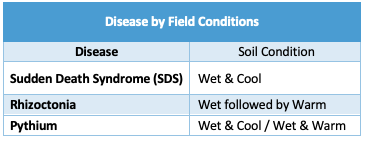ILSOYADVISOR POST
Understanding Seedling Diseases & Seed Treatments, Recap of Summit Breakout
During the first session of the 2021 Soybean Summit on February 10, I had the opportunity to learn from Dr. Kleczewski’s presentation, “Seedling Disease and Seed Treatment-What’s the deal?” If you were unable to attend this session, I would like to provide some insight on the topic. I hope after reading this blog you will be energized to follow this link and watch the full presentation: Seedling Diseases and Seed Treatments – What’s the Deal? - YouTube

How do seedling disease impact a crop?
Seedling diseases are soil borne and will infect a soybean after planting through emergence. Infection typically follows a prolonged time where the soils is wet to saturated, these diseases are typically referred to as the “Swimming Disease.” Other factors that can influence infection and severity include soil temperatures, soil types/texture, susceptible soybean genetics and field history.
Infections can ultimately lead to a Yield Reduction and Economic Impact, through reducing the availability to water and other essential nutrients, which can impact the growth and development of a small vegetative plant. Even though soybean yields can be obtained with low plant stand counts, there becomes a point where a given stand is too low to produce maximum yield. These areas would produce minimal yield as well as allow a very dense canopy which can cause season-long weeds to grow. In many situations these areas need to be replanted to help improve yield and ground cover.
What Seed Treatments ARE:
- They are one component of integrated pest management for soybean seedling diseases.
- Helps with soybean germination through about V2 growth stage.
- Does not eliminate 100% of seedling risk to planting early or challenging condition.
What Seed Treatments are NOT:
- Not a fumigant of the soil (100% reduction in disease).
- Does not provide unlimited duration of control (most likely 3-4 weeks).
- Does not guarantee higher yields (helps when planting into early or challenging conditions).
- Does not improve low seed germination (low seed germination from seed tag will not improve this).
- All Active Ingredients (AI) are not broad spectrum (multiple AI will reduce the most risk).
Recommendations:
- Determine if your soybeans are at risk from seedling diseases in the coming crop.
- Understand the genetic resistance or tolerance of the soybeans being planted.
- Understand the crop rotation and crop residue guidelines for minimizing issues.
- Do your homework on the AI that you are using for a seed treatment:
- You may not have the protection you think you have.
- A single AI will not control a broad spectrum of seedling diseases.
To view this presentation and others from Soybean Summit, check them out here.





Comments
Add new comment